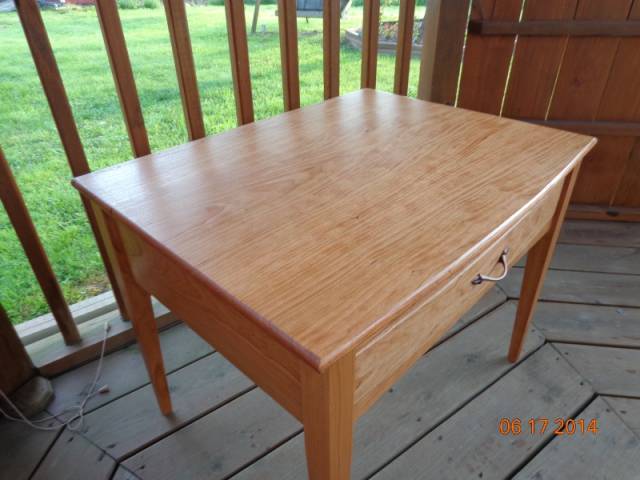
MontyJ
in over 11 years
Wipe on poly
I recently completed a small cherry table and finished it with colonial maple stain and wipe on poly. The entire table came out great except for the top. If you look at the pic below, you can see that it appears blotchy looking. That is the only place it looks like that. Construction details are:
Solid 3/4 cherry panel glue up of four boards all from the same board, sanded to 220 grit, one application of colonial maple for 70 seconds, let dry overnight, one coat of satin wipe on poly and let dry overnight, sanded with 320 then a second coat, let dry 3 hours, sanded with 320 and a final coat. I didn’t notice the blotching after the stain, and only the top looks like this.

Before I sand it down and try again, I would like to figure out what happened. Funny now that it’s in the house I don’t see the blotchy appearance unless I look at it at an angle in the right light. If it were in the stain, I would think it would be obvious all the time, which leads me to think I screwed up the poly somehow.
Mama already has her sewing box on it and is dead set against letting me take a sander to it. You’d think she bought it at an antique store or something. So I have to be able to convince her that I can fix it.
Where are the band-aids?---Pro Libertate!
4 Replies
Personally, I would leave it. Your wife doesn’t want you to touch it. Happy wife, happy life.
I googled “colonial maple” and a free different products came up. Sounds like a color. What product did you wipe on? Also which poly did you use? Is it oil or water based? I’m no expert on this – I only go with what I know and rarely experiment – but I do know that oil and water don’t always mix. What is it? Never oil over water, but water over oil is OK, or something like that. I’m sure someone more knowledgeable will chime in.
Losing fingers since 1969
As a general rule I don’t use penetrating stains on cherry, it will often splotch. If a penetrating stain is needed, I don’t sand past 150 grit. Sanding to a finer grit will also contribute to splotching.
I agree with Brian, at this point I’d leave it alone. Sanding it down and refinishing it probably won’t be worth the effort. The good news is cherry darkens with age and will probably even itself out, which is another reason I tend to not use stains on cherry especially dark stains.
If you choose to darken cherry, use a dye such as transtint. Dyes color the wood much more evenly and don’t muddy up the appearance.
Artisan Woodworks of Texas- www.awwtx.com
Thanks guys. The stain was Minwax Colonial Maple, the wipe on was Minwax oil based. Looks like I shot myself in the foot by sanding to 220. It’s water under the bridge now. The wife refuses to let me try to fix it. Maybe she’s afraid I’ll screw it up even more. She says she doesn’t see anything wrong with it. I guess if she’s happy, I’m happy.
Where are the band-aids?---Pro Libertate!
As Bill said, it wasn’t the poly, it was the stain. Cherry is notorious for blotching; a light coat of dewaxed shellac prior to the stain will help the stain penetrate evenly and avoid the blotching.
Rob, Sault Ste. Marie, Ontario











